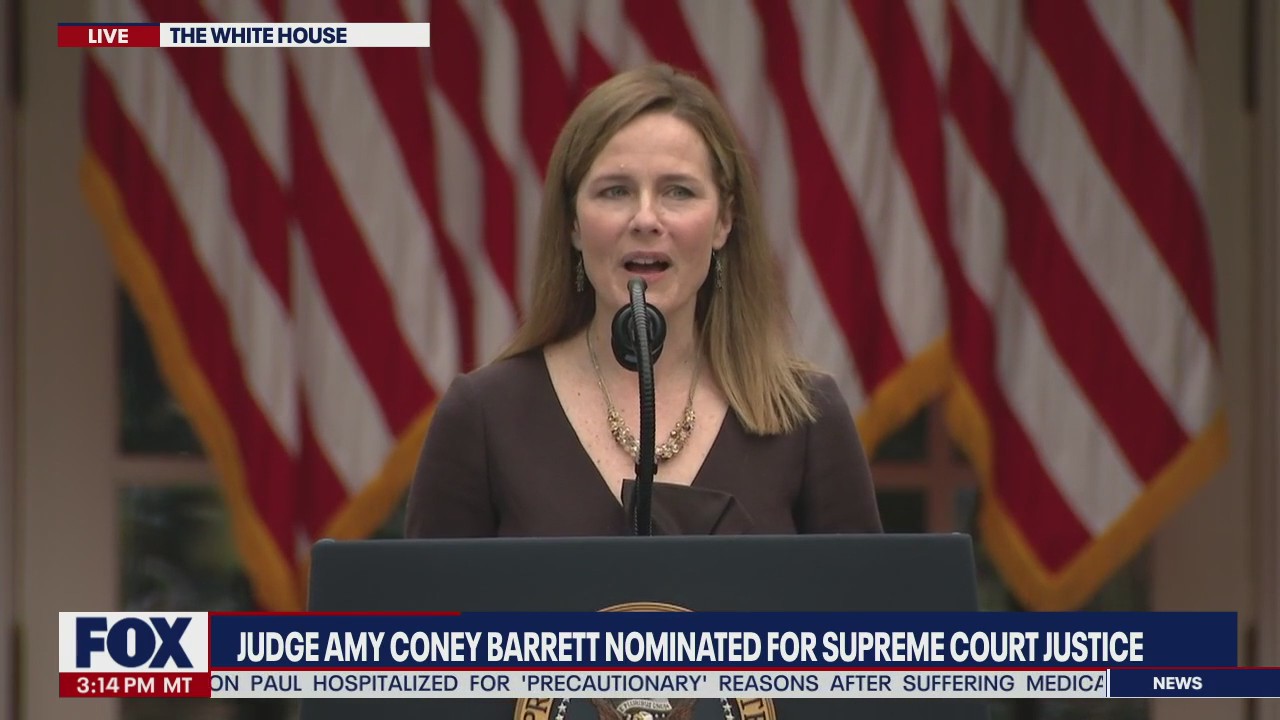Trump nominates Amy Coney Barrett to Supreme Court
President Donald Trump on Saturday announced his nomination to fill the U.S. Supreme Court seat vacated by the death of Justice Ruth Bader Ginsburg: Amy Coney Barrett.
Barrett, who had been considered a front-runner in the days following Ginsburg’s death, is a federal appellate judge and someone who has established herself as a reliable conservative on legal issues ranging from abortion to gun control.
Trump hailed Barrett as “a woman of remarkable intellect and character,” saying he had studied her record closely before making the pick.“I looked and I studied, and you are very eminently qualified,” he said as Barrett stood next to him in the White House Rose Garden.
"Over the past week, our nation has mourned the loss of a true American legend," Trump said. "Justice Ruth Bader Ginsburg was a legal giant and a pioneer for women. Her extraordinary life and legacy will inspire Americans for generations to come. Now we gather in the Rose Garden to continue our never-ending task of ensuring equal justice and preserving the impartial rule of law. Today it is my honor to nominate one of our nation's most brilliant and gifted legal minds to the Supreme Court. She is a woman of unparalleled achievement, towering intellect, sterling credentials and unyielding loyalty to the constitution: Judge Amy Coney Barrett."
Former Vice President Joe Biden responded to the nomination in a tweet.
“Today, President Trump nominated Judge Amy Coney Barrett to the Supreme Court — a jurist with a written track record of disagreeing with the Court’s decision to uphold the Affordable Care Act. Vote like your health care is on the ballot — because it is,” the tweet read.
Barrett is a devout Catholic and has been hailed by religious conservatives and others on the right as an ideological heir to conservative Antonin Scalia, the late Supreme Court justice for whom she once clerked.
If confirmed, her ascension would be sure to move the high court rightward on health care and other pivotal issues.
At just 48, Barrett would be the youngest justice and her tenure could last for decades.
Liberals have said Barrett’s legal views are too heavily influenced by her religious beliefs and fear her appointment to the nation's highest court could lead to a scaling back of hard-fought abortion rights. She also would replace Ginsburg, a justice who is best-known for fighting for women's rights and equality.
Trump had said multiple times that he intended to pick a woman to fill the seat. On Monday, he met with Barrett at the White House, according a person familiar with the vetting process who spoke to The Associated Press on condition of anonymity.
Ginsburg’s death set off a battle over whether her seat should be filled so close to the Nov. 3 election.
Republican Sen. Mitt Romney of Utah said this week that he supports voting to replace her, all but ensuring that Trump will have the backing for Barrett to be confirmed in the Republican-controlled Senate.
Senate Republicans are readying for confirmation hearings in two weeks, with a vote in the full chamber now expected before Election Day.
Barrett, who made her mark in law primarily as an academic at the University of Notre Dame, began teaching there at age 30. In 2017, Trump nominated Barrett to fill the vacant seat on the 7th Circuit Court of Appeals, a jurisdiction that covers Indiana, Illinois, and Wisconsin, which was confirmed later that year by the Senate.
Barrett was previously considered for the Supreme Court, among those on a list to replace retiring Justice Anthony Kennedy in 2018. Trump ultimately chose to nominate Justice Brett Kavanaugh.
Trump had released two lists with a total of 21 names of potential Supreme Court nominees during his previous presidential campaign and added another five names in 2017 after becoming president. Trump’s two nominees to the court, Justice Neil Gorsuch and Justice Brett Kavanaugh, were both drawn from the list.
Even before Ginsburg’s death, Trump had done the same in 2020, releasing an additional 20 names he would consider for the court, and encouraging Biden to do the same. Besides Barrett, other considerations on the list included Republican Sens. Ted Cruz of Texas and Tom Cotton of Arkansas.
When looking at justices who sat on the bench of the Supreme Court, President George Washington and President Franklin D. Roosevelt had the most with eight each. In recent history, President Ronald Reagan had the most with three.
This is Trump’s third opportunity to nominate a justice to the Supreme Court.
RELATED: Which president has selected the most Supreme Court justices?
This story was reported from Cincinnati. The Associated Press contributed.


